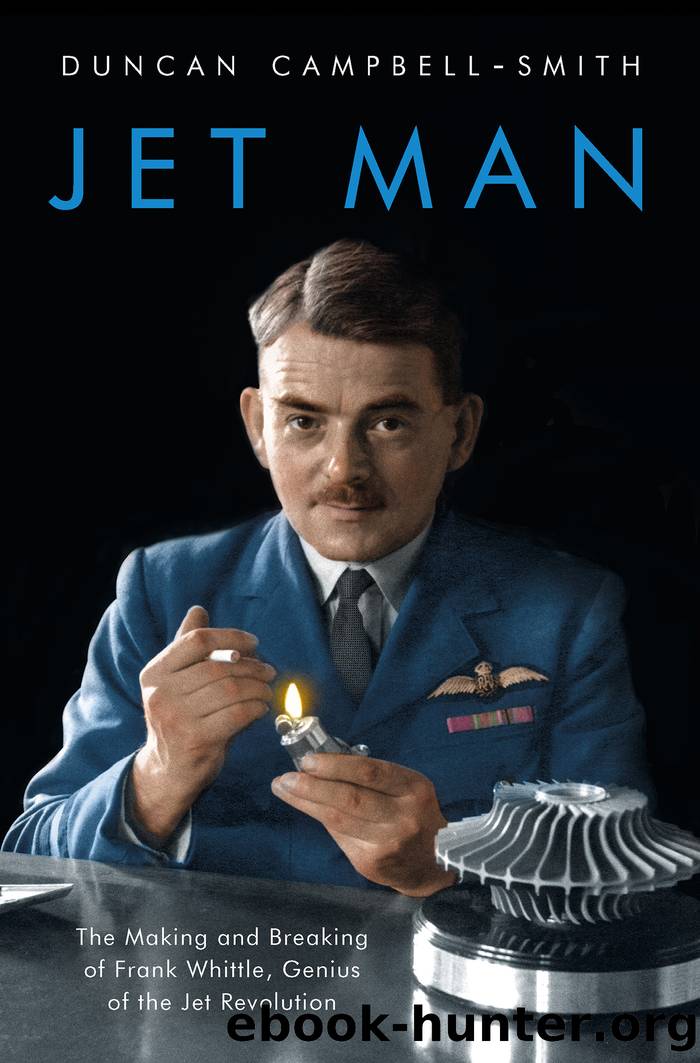Jet Man by Duncan Campbell-Smith

Author:Duncan Campbell-Smith [Campbell-Smith, Duncan]
Language: eng
Format: epub
ISBN: 9781788544689
Publisher: Head of Zeus
iv
Unknown to any of the E.28/39âs dazzled spectators at Cranwell, however, Whittle by May 1941 was harbouring a secret worry over the whole future of his engine. A couple of weeks after the party in April to celebrate the E.28/39âs initial taxiing, Whittle had led his engineering team to the test bed at the Ladywood Works for the first of several runs scheduled for the newly completed W.2 engine, recently received from Rover. He had designed it to produce almost twice as much thrust as the W.1 engine: the most significant change had involved adding many more vanes to the diffuser in an effort to improve its efficiency. This had undoubtedly left Whittle feeling apprehensive, though. By his own calculations, the W.2âs components were likely to fall short of their efficiency targets. He therefore had low expectations of the new engine as they prepared it for a first run up to full power on 25 April 1941. What happened next nonetheless came as a shock. Just as it was approaching its operating speed, at around 11,000 rpm, the engine gave a series of terrifying bangs and began to shake violently in its test frame. To Whittleâs consternation, it had effectively gone into reverse, forcing compressed air back from its combustion chambers and out through the front of the engine. Flames shot out of the air intake and all the instruments attached to the engine went wild. A moment later they settled back to normal, only for the cycle to repeat itself. He hastily shut the engine down, and the runs scheduled for the rest of the day were postponed. Whittle retired to Brownsover Hall and his slide rule, to begin a careful analysis of what had gone wrong.
This was an entirely new phenomenon: neither the WU, in any of its three permutations, nor the W.1 had ever run into it. (Sheer luck, as would soon become clear.) Various experimental cures were applied over the next several days, but it was quickly apparent to Whittle that they had encountered a fundamental problem. The normally steady flow through the compressor was becoming destabilised, triggering the convulsions of the engine and sending the air âsurgingâ backwards. With the combustion chamber emptied of air, the compressor was able to reassert itself â but the process would then be repeated. No matter how they varied the acceleration of the engine, it could not be taken past a âbreakdown speedâ in a range just short of 12,000 rpm. This diagnosis, though, stopped short of an explanation. Whittle had no idea what was causing the surging. Nor was there a test rig at Lutterworth â or, indeed, anywhere else â with sufficient power to run the W.2âs compressor on its own, for a methodical study of the problem. It was deeply vexing.
By the day of the E.28/39âs triumph at Cranwell on 15 May, Whittle knew that surging posed a mortal threat to the entire development programme. The solution might involve redesigning every major component of the engine. It was impossible to know how many remedial changes might be required.
Download
This site does not store any files on its server. We only index and link to content provided by other sites. Please contact the content providers to delete copyright contents if any and email us, we'll remove relevant links or contents immediately.
Machine Learning at Scale with H2O by Gregory Keys | David Whiting(4108)
Never by Ken Follett(3762)
Harry Potter and the Goblet Of Fire by J.K. Rowling(3759)
Unfinished: A Memoir by Priyanka Chopra Jonas(3316)
Fairy Tale by Stephen King(3193)
The Man Who Died Twice by Richard Osman(2979)
Will by Will Smith(2771)
Rationality by Steven Pinker(2273)
The Dark Hours by Michael Connelly(2220)
It Starts With Us (It Ends with Us #2) by Colleen Hoover(2176)
The Storyteller by Dave Grohl(2152)
Can't Hurt Me: Master Your Mind and Defy the Odds - Clean Edition by David Goggins(2152)
The Dawn of Everything: A New History of Humanity by David Graeber & David Wengrow(2105)
Friends, Lovers, and the Big Terrible Thing by Matthew Perry(2100)
The Becoming by Nora Roberts(2063)
The Stranger in the Lifeboat by Mitch Albom(2032)
Cloud Cuckoo Land by Anthony Doerr(2013)
Einstein: His Life and Universe by Walter Isaacson(1953)
Love on the Brain by Ali Hazelwood(1935)
